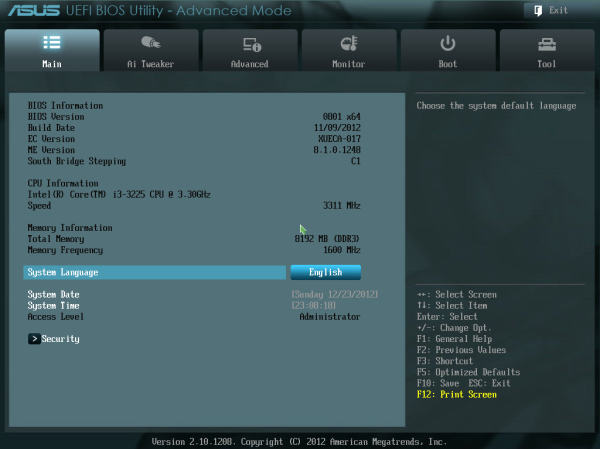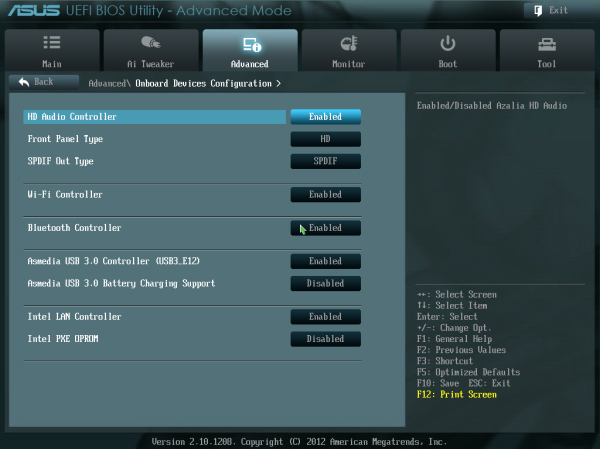Z77 mITX Round-Up: Five of the Best – MSI, Zotac, ASRock, EVGA and ASUS
by Ian Cutress on December 31, 2012 7:00 AM EST- Posted in
- Motherboards
- MSI
- ASRock
- EVGA
- ZOTAC
- Asus
- Ivy Bridge
- Z77
- mITX
ASUS P8Z77-I Deluxe BIOS
The BIOS from ASUS has been a rock solid part of their motherboard package since the advent of graphical BIOSes on mainstream motherboards hit a couple of years ago. ASUS divides functionality at the top level, providing an easy mode with images and bars to help identify the main points of the product, as well as a one button click for greater performance and boot priority. The other side of the coin is in advanced mode, where the feature sets are laid out to make sense to the user, and all options take the form of the old text-based BIOS. This lays the plans down for other features of the system, like USB BIOS Flashback.
While the BIOS from ASUS is one of the best on offer out of all the motherboard manufacturers today, there is room for improvement in all of them. The beating heart of a graphical BIOS should be functionality, representation of those functions, and usability. Very rarely do I ever see all three meshed together. Part of this is down to the size of the BIOS – even ASUS limit themselves to a 64 megabit BIOS chip, meaning 8 MB of storage to play around with for all the initialization procedures and protocol. It makes efficiency important in BIOS coding, and vendors are unwilling to double the size of the BIOS because of the additional cost. With the motherboard market in decline, innovation in this area is unlikely any time soon, but with bulk buying deal, ASUS could lead that charge. Then all would be left to do is to encourage the BIOS engineers and developers to create something.
The ASUS BIOS however is one of the best available today. The front ‘easy’ mode screen is full of information that a system builder or diagnostician needs before opening up a case – we get access to the motherboard model, BIOS version, CPU installed, the size of the memory installed, CPU and system temperatures, fan speeds, voltages and the boot order. There are options to apply a basic turbo mode, a power saving mode, a Boot Menu to select which device to boot from and shortcuts to advanced mode features.
Stepping into the advanced mode gives us a tabbed interface of options. When first entering we are presented with the Main screen, which offers similar data to the easy mode, as well as security options.
The next tab along is the AI Tweaker, where all the cool stuff happens. Users can choose to overclock their system through this menu, with options for CPU multiplier, CPU base frequency, MultiCore Enhancement, XMP on the memory, separate memory straps, and associated voltages. There are separate menu options as well to deal with memory timing, power management, and the DIGI+ VRMs.
The Advanced menu is for enabling and disabling the functionality on board – this extends to processor functionality (to disable sleep states), SATA functionality, USB functionality, Rapid Start, Smart Connect, integrated graphics, PCIe configuration and onboard devices such as audio, network, WiFi and Bluetooth.
Fan controls are hidden in the Monitor tab, which gives us details on temperatures, fan speeds and voltages. The fan options are relatively basic compared to those offered in the OS, despite the fact that the graphical BIOS way of thinking should offer some form of stepped graphical control over fan speeds. I look forward to seeing it on future BIOS designs.
The Boot tab allows users to adjust the boot order or select a device for a single boot override. Users of Windows 8 can also take advantage of the Fast Boot option which reorganizes the initialization procedure at POST in exchange for not being able to get into the BIOS without a BIOS reset or selecting an OS software option.
The ASUS BIOS also supports BIOS flashing if the correct file is on an attached storage device, although not directly from the internet. A newer feature in ASUS’ offering allows users to save BIOS profiles direct to a USB stick as well.
Another feature to mention is USB BIOS Flashback, which allows users to update a BIOS without having a CPU, memory or a graphics device installed. With the correct BIOS file and filename on a USB stick, by pressing a button on the IO panel, it will update the BIOS onboard (exact procedure is listed in the manual).























54 Comments
View All Comments
Bullwinkle J Moose - Monday, December 31, 2012 - link
Hey yeah, Ian haz a good pointThat Crappy Gigabyte H61n-USB3 doesn't have Chipset USB3
But it does however boot just fine to a USB3 Windows to go drive at USB3 speeds
It also boots to Linux and XP due to the Non-Locked down Bios so we wouldn't want that either would we
and it takes a full 9 seconds to boot XP compared to the super de duper fast 7 second Windows 8
So we should spend more money and get locked into a closed system
After all, that is the future!
Limitations are fun so be happy as we lock down the Internet as well
After all, there are scarey Monsters out there
A man has to know his limitations
Clint Eastwood
Bullwinkle J Moose - Monday, December 31, 2012 - link
Ian haz a good point about the memory tooThat Gigabyte H61 board only takes up to 16GB of RAM
How much do these Z77 boards take by the way?
Was it this site or Maximum PC where the reviewers stated that in everyday use, you will notice no difference in speed between Sata 2 & 3 when you are using the latest and greatest SSD so I probably don't need the RAID capability on my H61 either
Keep up the good work Ian
Death666Angel - Wednesday, January 2, 2013 - link
It seems that someone just discovered sarcasm. Good for you!mczak - Monday, December 31, 2012 - link
H61 is not limited to one single sided DIMM per channel, double sided are just fine. It only accepts one per channel (at least it's specced that way) but since none of these mini-ITX boards have more than two memory slots this wouldn't matter at all here (max memory is still 2x8GB regardless).Frankly I'm not sure losing PCIe 3.0 is a big deal with mini-itx boards in any case but either way it isn't exactly true there are h61 boards supposedly supporting this (as it's got nothing to do with the chipset anyway all the pcie 3.0 signals coming directly from the cpu, though it would require bios support).
This leaves us with losing SATA 6 Gbps - this might indeed make some minimal difference in real world, provided you use a SSD and not a HD.
The major point imho (aside from overclocking) would be missing USB 3.0, which obviously makes a big difference when using external harddisks etc. Granted that could be done with separate usb controller but probably not a good idea since space is limited.
H61 IIRC also will lose the possibility of using 3 display outputs simultaneously. Maybe something like H77 would make more sense for mini-ITX as it pretty much only loses overclocking (plus the ability to split the 16 x pcie 3.0 lanes into 2x8 though I guess this has nothing to do with the chipset itself really, but in any case it won't be missed on mini-itx). So if you don't want to overclock, you wouldn't miss anything at all with H77 on a mini-itx board.
Etern205 - Saturday, January 5, 2013 - link
I also notice that as well, most sites will only review Z77 mITX boards instead of H61 or H77. Not all will need a Z77, Z77 is mostly for enthusiast or for those who are into the technical stuffs. For the average Joe or Jane any mITX board will do. If you tell them it's H61 or Z77, they probably won't care too much on the difference.piroroadkill - Wednesday, January 2, 2013 - link
You can't easily upgrade the chipset later. With a small up-front investment, you get the full feature set, and why not?Bullwinkle J Moose - Sunday, January 6, 2013 - link
Oh Boo Hoo, I can't easily upgrade to an overclocking chipset or void the warranties of my hardware componentsI am just stuck with a totally stable system
Boo Hoo
How can I possibly break this ?
What has the World become ?
Poor me
Boo Hoo
Bullwinkle J Moose - Sunday, January 6, 2013 - link
Why not?Because the H61 is exactly what I wanted
and anything else is NOT !
can you hear me now?
EVGA KINGPIN - Friday, November 19, 2021 - link
I still use my Z77 FTW board , have had it running without turning it off since 2015. evga is the best ,also my EVGA GTX 980 KINGPIN is still running strong,,,thanks EVGA for quality products, JRTsherlockwing - Monday, December 31, 2012 - link
Where is the Gigabyte?